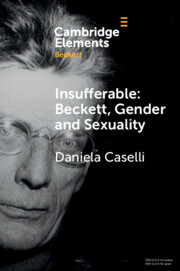Element contents
Insufferable: Beckett, Gender and Sexuality
Published online by Cambridge University Press: 21 September 2023
Summary
- Type
- Element
- Information
- Series: Elements in Beckett StudiesOnline ISBN: 9781009244763Publisher: Cambridge University PressPrint publication: 19 October 2023
References
- 2
- Cited by

